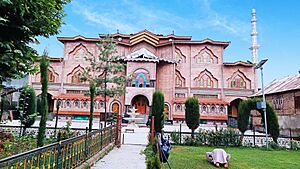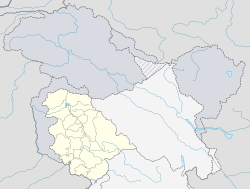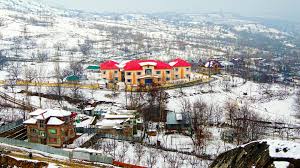Beerwah, Jammu and Kashmir facts for kids
Quick facts for kids
Beerwah
Beeru
|
|
|---|---|
|
Town
|
|
| The Town And The Commonality Of Beerwah Along Banks Of Sukhnag River | |

Jamia Masjid Beerwah
|
|
| Nickname(s):
The Gate Way To Doodhpathri
|
|
| Country | |
| Union territory | Jammu and Kashmir |
| District | Budgam |
| Tehsil Established | 1883 |
| Named for | Bairam Hillock |
| Municipal committee | Townhall of Beerwah |
| Villages in Beerwah | No Of Villages: 126 |
| Government | |
| • Type | Municipal committee Beerwah |
| • Body | Beerwah Municipal Committee |
| Area | |
| • Total | 4,950 km2 (1,910 sq mi) |
| Elevation | 1,598 m (5,243 ft) |
| Population
(2016)
|
|
| • Total | 168,348 |
| • Density | 34.01/km2 (88.08/sq mi) |
| Demonym(s) | Beerwek, Beerweigns |
| Languages | |
| • Official | Kashmiri, Urdu, Hindi, Dogri, English |
| • Spoken | Kashmiri |
| Time zone | UTC+5:30 (IST) |
| Postal code |
193411
|
| Vehicle registration | JK04 |
Beerwah, also called Beeru, is an old town in Jammu and Kashmir, India. It is a popular place for tourists to visit. Beerwah is also a subdistrict and a municipal committee in the Budgam district.
It is one of the oldest tehsils (a type of administrative division) in the region. Beerwah is known as one of the biggest towns in the Budgam district. It is located near the River Sukhnaag.
The name Beerwah might come from the Sanskrit word "Behroop." This word means "land of springs," which makes sense because Beerwah has many natural springs. There are seven springs just in the town area.
Beerwah is the main way to reach the snowy resorts of Doodhpathri and Tosamaidan. Doodhpathri is about 19 km from Beerwah. Tosamaidan is about 23 km away. Because of this, Beerwah is often called "The Gateway of Doodhpathri" and "The Gateway of Tosamaidan."
Contents
Exploring Beerwah's Landscape
Beerwah is located about 1,598 meters above sea level. It sits at the bottom of the Pir Panjal mountain range. The town has flat areas to the north, east, south, and southwest.
A hill called Bairam is on its southern side. On the eastern side of Bairam, there is a famous cave. This cave is linked to the life of Acharya Abhinavagupta, a great philosopher from Kashmir. The cave is about 85 meters high on the side of a ridge. It overlooks a narrow valley with evergreen forests and the Sukhnag River flowing through it.
The land around Beerwah has flat, raised areas called karewas.
Rivers and Streams in Beerwah
The region has many forests and several mountain rivers and streams. These include the Mala Kol, Lear Kol, Ahij Kol, Laen, Zaen, Mean, and Sona Mean. The Ahij Kol, Laen, and Sona Maen all start from the Sukhnag.
The Mala Kol is sometimes called the "deaf and dumb stream." This is because of a story that says a saint named Syed Taj-ud-Din arrived in Khag. The stream then quietly followed him from Sukhnag to Sikandarpora. Local people still tell stories about these streams.
The Sukhnag River divides Beerwah into two parts. These are the Old town (on the west bank) and the New town (on the east bank).
Beautiful Pastures Near Beerwah
There are several large, open grasslands, or pastures, around Beerwah.
Tosamaidan Pasture
Tosamaidan is a big pasture with a long history. It is surrounded by thick forests of deodar trees. It is about 10 km from Khag in the Himalayas. In the past, Mughal travelers used this route to go from Poonch and Punjab to Kashmir.
Until 2017, the Indian army used this area. Sadly, some people died because of old explosive materials left behind. Today, local shepherds and the Gujjar community use the area for grazing their animals. Many people also visit to find medicinal plants.
Pehjan Pasture
Pehjan is another high mountain pasture. It is about 25 km from Khag, deep in the Himalayas. From here, you can see Wular Lake. This place is known for its local flowers and plants. It also offers amazing views of the Nanga Parbat peak, which is about 26,696 feet high.
Khag Pasture
The Khag pasture is in the southwest of Kashmir. It is between 8,000 and 14,000 feet above sea level. It is surrounded by mountains that are about 17,000 feet high. In the summer, it is very beautiful. Nomadic Bakarwals bring their cattle here to graze.
Natural Springs of Beerwah
The Beerwah region has many springs that are important to local people and tourists.
Sutharan Spring
Sutharan is a spring located near Tosamaidan. Local stories say that Lord Ram Chandra, along with Lakshman and Sita, stayed here during his 12-year exile. The spring is named after Sita, who is believed to have bathed in it.
Naranag Spring
Naranag spring, also called Narain Nag, is near Khag village. A local story tells of an ascetic who dropped sheep dung into a lake near Tosamaidan. Days later, he saw the dung floating in Naranag. He then put turmeric powder in the first lake, and it appeared in Naranag.
Sukhnag Spring
The Sukhnag (Sokhanag) spring is known as the "spring of solace." It forms a 20-foot high waterfall at Kanj Zubji.
Pushkar Nag Spring
Pushkar Nag is east of Poshker village, between Khag and Ferozpora. It is named after its village. Historically, during the month of Sawan, Kashmiri Pandits would pray and bathe in this spring. Some people still do this ritual today.
Gandhak Nag Spring
Gandhak Nag is a sulfur spring in Darang Khaipora village, Khag. The sulfur in the water is believed to have healing properties, making it important to the local community.
Unique Natural Formations
Nakwaer Pal (Nostril Rock)
Nakwaer Pal, or the "nostril rock," is near the Pehjan pasture. It is 14,000 feet high and is the tallest peak in the area. Local stories say that when the Kashmir valley was a lake (Sati Sar), boats were tied to this rock. Today, there is an iron hook inside it, also called Ded Bal or Lal Khanen Gher. Shepherds and Gujjars from nearby villages bring their animals here.
Beerwah's Past: A Look at Its History
Beerwah was an important pargana (a type of district) during the Mughal rule. It included parts of what was once the Srinagar district.
In 1766, Governor Lal Mohammad Khatak built a fort on Bairam hill. Governor Abdullah Khan repaired it in 1801. However, an earthquake destroyed the fort in 1884.
In 1962, Beerwah, along with Budgam and Baramullah, became a tehsil called Tehsil Ranbir Singh. This happened with the help of Sir Syed Sani Mawlana Syed Ali Shah Bukhari. Later, in 1979, Budgam became its own separate tehsil.
Beerwah was given subdistrict status in the 1970s, supported by Mawlana Syed Ali Shah Bukhari. But it was fully put into action only in 2013. This was done by Chief Minister Omar Abdullah and Mirwaiz of Central Kashmir Mawlana Latief Bukhari.
People of Beerwah: Demographics
According to the 2011 India census, Beerwah had a population of 167,850 people. About 53% were men and 47% were women.
The average literacy rate in Beerwah was 63%. This is higher than India's national average of 59.5%. About 67% of men and 53% of women could read and write. Around 16% of the population was under 6 years old.
Beerwah has 124 villages. Most of these villages are sunni Muslim. There are also 7 shia Muslim villages and 5 Sikh villages. Beerwah is the largest voting area in the Budgam district.
Beerwah's Economy: How People Make a Living
Most of the local economy in Beerwah comes from farming. Farmers grow crops like rice, mustard, vegetables, apples, walnuts, pears, apricots, cherries, and almonds.
Beerwah has many important services. These include post offices, fire stations, banks, police stations, and local courts. There are also three subdivision hospitals and several health care centers in the villages. An office for the subdivision magistrate (SDM) opened in Beerwah in 2013. This happened when Beerwah became a subdistrict. The Beerwah market is the main business area in the town.
Smaller businesses in Beerwah include designing carpets (called Kaleen in Kashmiri). People also design and knit shawls and do embroidery. Kashmiri carpets and shawls are sold all over the world. However, due to rising costs and low income, many local textile makers have started other businesses.
Learning in Beerwah: Education
Each area in Beerwah has a zonal education officer. The schools in the area include both government and private schools. They offer different levels of education.
In Beerwah, the government runs two higher secondary schools: Boys Higher Secondary School and Girls Higher Secondary School. About two thousand students attend these schools.
The government also runs three middle schools and six primary schools within the town limits. Many private schools also operate in Beerwah. Mazhar ul Haq High School is the oldest school in the valley. Sir Syed Sani Mawlana Syed Ali Shah Bukhari founded it in 1934. It was one of the few schools that provided education in North and Central Kashmir when there were no other government or private schools. This school is run by the Mazhar ul Haq Trust.
SAMIE Institutes were founded in November 2000 by SAMET. This was under the leadership of Syed Abdul Rouf Bukhari, a well-known educationist. For the past two decades, SAMIE has offered modern, secular education in the area. SAMIE (Syed Ali Memorial Institute of Education) includes a school, a training college, and a nursing college.
Government Degree College Beerwah is a major government college. It is connected to the University of Kashmir. It is the only government higher education institution in the area.
Other educational places include the District Institute of Education and Training (DIET). This center trains teachers and offers education programs. SAM College of Education Beerwah and CED College of Education in Narbal are also connected to the University of Kashmir.
Getting Around: Transportation in Beerwah
Most people in Beerwah have their own ways to travel. There is also a public transportation system. This includes buses and cars. Beerwah has a bus stand and two taxi stands.
The closest airport to Beerwah is the Srinagar Airport (SXR), which is about 28 km away.
The nearest railway station is Mazhama Railway Station Magam, about 11 km away.
The Jammu and Kashmir State Road Transport Corporation (J&K SRTC) connects Beerwah to most major towns and cities. This connection is through Srinagar via National Highway 1A.
Many private companies also run transport services. They offer 24-hour taxi services.
See also
 In Spanish: Birwah para niños
In Spanish: Birwah para niños




